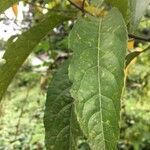Trees to 30 m tall, to 1.7 m d.b.h. Branches brown-gray; branchlets yellowish brown villous. Petiole 1-1.5 cm, villous, glabrescent; leaf blade obovate-oblong to oblong-lanceolate, 9-14 × 3-4.5 cm, papery or membranous, both surfaces villous when young, glabrescent when mature, lateral veins 10-13 per side, slightly prominent abaxially, impressed adaxially, base broadly cuneate, margin serrate, apex acute or obtuse. Racemes in axils of current and fallen leaves, 2-4 cm; peduncles villous. Pedicel ca. 5 mm. Sepals 5, lanceolate, ca. 5 × 1.5 mm, both surfaces villous. Petals 5, ca. as long as sepals, laciniate to 1/2 their length, lower 1/2 villous. Stamens 25; anthers setose at apices. Ovary 5-loculed, densely tomentose; style ca. 5 mm. Drupe globose, 1.7-2 cm in diam., 5-loculed. Seed 1 per locule; endocarp hard, rugulose. Fl. Aug-Sep, fr. Sep-Nov.


